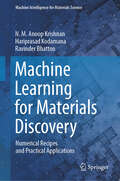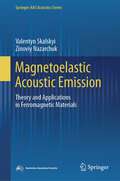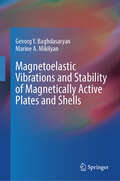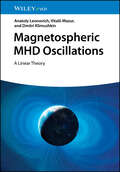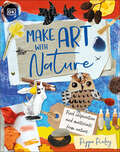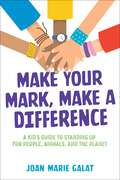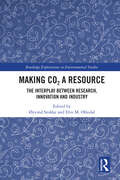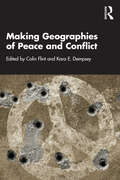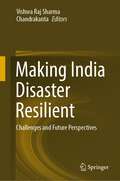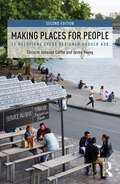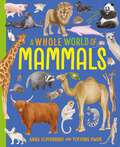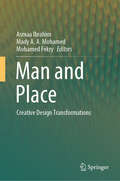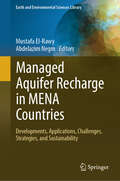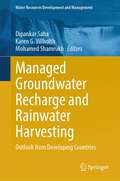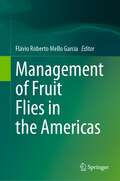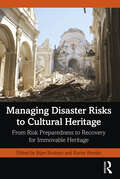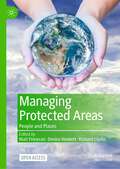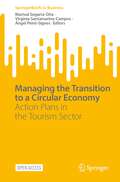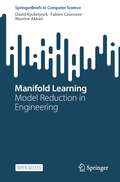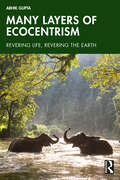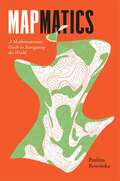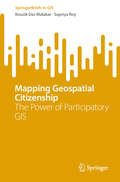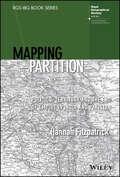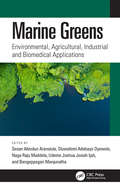- Table View
- List View
Machine Learning for Materials Discovery: Numerical Recipes and Practical Applications (Machine Intelligence for Materials Science)
by Hariprasad Kodamana Ravinder Bhattoo N. M. KrishnanFocusing on the fundamentals of machine learning, this book covers broad areas of data-driven modeling, ranging from simple regression to advanced machine learning and optimization methods for applications in materials modeling and discovery. The book explains complex mathematical concepts in a lucid manner to ensure that readers from different materials domains are able to use these techniques successfully. A unique feature of this book is its hands-on aspect—each method presented herein is accompanied by a code that implements the method in open-source platforms such as Python. This book is thus aimed at graduate students, researchers, and engineers to enable the use of data-driven methods for understanding and accelerating the discovery of novel materials.
Magnetoelastic Acoustic Emission: Theory and Applications in Ferromagnetic Materials (Springer-AAS Acoustics Series)
by Valentyn Skalskyi Zinoviy NazarchukThe book presents theoretical and experimental studies to establish the relationship between volume jumps of the 90° domain wall in a ferromagnetic material and the magnitude of the half-space surface displacement caused by it. A method of evaluating the influence of the external magnetic field on the stress intensity factor at the tip of the crack-like defects in ferromagnets is discussed. The influence of hydrogen on the generation of magneto-elastic acoustic emission signals of ferromagnets is described. The features of magneto-elastic acoustic emission due to the presence of plastic deformation, structural changes, and volumetric damage in such structural materials are shown.
Magnetoelastic Vibrations and Stability of Magnetically Active Plates and Shells
by Gevorg Y. Baghdasaryan Marine A. MikilyanThis book introduces the reader to methods of mathematical modeling and solving non-stationary (dynamic) problems of the theory of magnetoelasticity, as well as to give an idea of the wealth of physical effects caused by the interaction of electromagnetic and mechanical phenomena in magnetically active elastic thin bodies. The studies are mainly limited to a model of isotropic body under the assumption of small deformations. In the first chapter of the book, based on the basic connected nonlinear equations and relations of mechanics and quasi-static electrodynamics of continuum media, a system of equations of magnetoelasticity, surface conditions, and governing equations describing the behavior of disturbances in a magnetoactive medium interacting with an external magnetic field is obtained. On this basis, in Chapters 2 and 3, using the main equations and relations of magnetoelastic vibrations and stability of magnetically soft, thin plates and shells are obtained. By solving specific applied problems, a number of qualitative and quantitative results were identified, caused by the interaction of mechanical and magnetic phenomena in ferromagnetic thin bodies. An approximate formula is obtained to determine magnetohydrodynamic pressure on the oscillating surfaces of plate flowing by supersonic flow of perfectly conducting gas in the presence of magnetic field. This formula is the generalization of well-known formula obtained on the basis of the classical piston theory of gas dynamics in the case of magneto-gas-dynamic flow. On this basis, it became possible to solve complex problems of aeromagnetoelasticity. In the 4th and 5th chapters magnetoelastic processes in superconducting thin shells located in stationary and non-stationary magnetic fields are studied. Two-dimensional equations and corresponding conditions are obtained, which characterize vibrations and stability of superconducting cylindrical and spherical shells under the influence of the given magnetic field. By solving specific problems, the possibility of loss of both static and dynamic stability of thin superconducting bodies under the influence of external magnetic field has been established. The sixth chapter is devoted to mathematical modeling and investigation of issues of dynamics of magnetostrictive plates in magnetic fields (stationary and non-stationary) of several orientations. To study the processes of magnetoelastic interaction in the plate under consideration with complex physical properties of its material, the main postulates of the classical theories and methods were used. The influence of plate in-homogeneity on the processes under consideration was also studied. Dynamic processes in layered plates have been studied. It is shown that heterogeneity is sufficient to control optimally the studied dynamic processes, especially those that arise as a result of interaction. The last 7th chapter is devoted to the investigation of stability of dielectric thin plates in a supersonic flow of perfectly conducting gas in the presence of magnetic field. The problems were studied in both linear and nonlinear formulations. Based on the formula obtained by the authors specific problems of stability were solved. Influence of magnetic field on the flutter characteristics is studied.
Magnetoelectronic, Optical, and Thermoelectric Properties of Perovskite Materials (SpringerBriefs in Materials)
by Rachid MasrourThis book undertakes an extensive exploration of manganese-based compounds, such as T₁₋ₓSrxMnO₃ (T = La, Pr; x = 0.35, 0.25) using density functional theory and Monte Carlo simulations with a focus on understanding their electronic, magnetic, and magnetocaloric properties. Ba₁₋ₓSrxFeO₃ (x = 0, 0.2) is also studied via different approximations, offering a comparative perspective. In addition, the book looks at the influence of magnetism using Monte Carlo simulations, revealing crucial parameters and examining the GdCrO₃ system through DFT and Monte Carlo simulation, shedding light on recent experimental observations. Additionally, Monte Carlo studies investigate magnetic and magnetocaloric features of Sr₂FeMoO₆, La₂SrMn₂O₇ bilayer manganite, perovskite ferromagnetic thin films' surface effects, and SmFe₁₋ₓMnxO₃ perovskite. In essence, this book significantly advances our comprehension of magnetic and magnetocaloric phenomena across diverse materials and is well-suited for both experimentalists and computational researchers working in this field.
Magnetospheric MHD Oscillations: A Linear Theory
by Anatoly Leonovich Dmitri Klimushkin Vitalii MazurMagnetospheric MHD Oscillations A groundbreaking new theory of the magnetosphere The magnetosphere is the region around Earth in which our planet’s magnetic field exerts its influence to trap charged particles. Waves in this magnetosphere, known as magnetohydrodynamic (MHD) oscillations, are caused by interactions between these charged particles, Solar wind pulses, and the magnetic field. The predictable interval between these oscillations enables them to serve as tools for understanding the magnetospheric plasma which comprises the field. Magnetospheric MHD Oscillations offers a comprehensive overview of the theory underlying these waves and their periodicity. Emphasizing the spatial structure of the oscillations, it advances a theory of MHD oscillation that promises to have significant ramifications in astronomy and beyond. Magnetospheric MHD Oscillations readers will also find: Theorizing of direct relevance to current satellite missions, such as THEMIS and the Van Allen Probe In-depth discussion of topics including Alfven resonance, waveguides in plasma filaments, and many more Detailed appendices including key calculations and statistical parameters Magnetospheric MDH Oscillations is ideal for plasma physicists, theoretical physicists, applied mathematicians, and advanced graduate students in these and related subfields.
Make Art with Nature: Find Inspiration and Materials From Nature
by Pippa PixleyGet creative and make incredible pieces of art using rocks, wood, berries, flowers, and leaves.Learn how to pour paint onto a canvas, how to put pencil to paper and draw, how pieces of old paper can make a beautiful collage, and how different mediums can come together to create incredible prints, all with artist Pippa Pixley. Become inspired as Pippa takes you into the outdoors and shows you a wide range of artistic techniques, from understanding basic color theory, to creating texture, movement, and fluidity in your own work. You'll soon be able to turn a blank canvas into a piece of art! Find out how the very earth beneath your feet can be used to make paints and pastels, and how flowers and vegetables can be repurposed to create inks. There is much to look forward to! Learn how to master different art forms, but also how to make your own art supplies. Simple-to-follow instructions, fun facts, tips, and tricks, as well as lively illustrations and photography will allow you the creativity to run wild!Art can be used to express our thoughts, ideas, and feelings. It can be a relaxation tool, a way to keep busy, a future career path, or just a hobby. But the magic of art is that it can come in many different forms! Perfect for budding artists or for those who just want a moment to enjoy the wonders of nature. Your curiosity and exploration will be unlocked, as this book has something for everyone!
Make Your Mark, Make a Difference: A Kid's Guide to Standing Up for People, Animals, and the Planet
by Joan Marie GalatTake the first steps into activism with this comprehensive middle grade guide that empowers readers to choose and become knowledgeable in a cause they are most passionate to reform, and to create meaningful change through learning what&’s already been accomplished—and what can still be done.Getting involved can be an overwhelming prospect, but this guide provides readers with tools to become informed and effective activists with an accessible approach offering hope and perspective. From Black Lives Matter and light pollution to climate change and healthcare equity for all, the book leads readers through an overview of issues, an essential human rights background, and stories of how other young activists tackle local, national, and international problems. Readers will discover a multitude of ways to build change and learn that every contribution matters.
Making CO2 a Resource: The Interplay Between Research, Innovation and Industry (Routledge Explorations in Environmental Studies)
by Elin M. Oftedal Øyvind StokkeThis interdisciplinary book explores how CO2 can become a resource instead of a waste and, as such, be a tool to meet one of the grandest challenges humanity is facing: climate change.Drawing on a Norwegian narrative that has significance for a global audience, Øyvind Stokke and Elin Oftedal introduce in-depth, multi-perspective analyses of a sustainable innovation research experiment in industrial carbon capture and utilisation technologies. Building on extensive literature within marine sciences, sustainability research, and environmental philosophy and ethics, this book documents how a misplaced resource like CO2 can become valuable within a circular economy in its own right, while at the same time meeting the challenge of food security in a world where food production is increasingly under pressure. The book is diverse in scope and includes chapters on how to reduce the environmental footprint of aquaculture by replacing wild fish and soy from the Amazon, how to optimise the monitoring of aquatic environments via smart technologies, and how to replace materials otherwise sourced from natural environments. The authors also analyse the pivotal role of the university in driving innovation and entrepreneurship, the pitfalls of different carbon technologies, and explore how the link between petroleum dependence and CO2 emissions has been addressed in Norway specifically.Making CO2 a Resource will be of great interest to students and scholars of climate change, environmental ethics, environmental philosophy, sustainable business and innovation, and sustainable development more broadly.
Making Geographies of Peace and Conflict
by Colin Flint Kara E. DempseyThis book illustrates the diversity of current geographies, ontologies, engagements, and epistemologies of peace and conflict. It emphasizes how agencies of peace and conflict occur in geographic settings, and how those settings shape processes of peace and conflict. The essence of the book’s logic is that war and peace are manifestations of the intertwined construction of geographies and politics. Indeed, peace is never completely distinct from war. Each chapter in the book will demonstrate understandings of how the myriad spaces of war and peace are forged by multiple agencies, some possibly contradictory. The goals of these agents vary as peace and war are relational, place-specific processes. The reader will understand the mutual construction of spaces and processes of peace and conflict through engagement with the concepts of agency, the mutual construction of politics and space, geographic scales, multiple geographies, the twin dynamics of empathy/othering and inclusivity/partitioning, and resistance/militarism. The book discusses the intertwined nature of peace and conflict, including reference to the environment, global climate change, borders, technology, and postcolonialism. This book is valuable for instructors teaching a variety of senior level human geography courses, including graduate-level classes. It will appeal to those working in political geography, historical geography, sociology of geographic knowledge, feminist geography, cultural and economic geography, political science, and international relations.
Making India Disaster Resilient: Challenges and Future Perspectives
by Vishwa Raj Sharma ChandrakantaVarious natural and man-made hazards are nowadays increasingly considered as disasters, particularly by individual and communities are lacking in awareness and where a system as a whole has no adequate management mechanism. Consequently, the world is facing serious negative outcome in form of loss of life, injury, disability, loss of property, infrastructure, and economic disruption followed by psycho-social disorders. Other than this, disasters adversely affect wildlife and environment in long terms. Developing countries are worst sufferers as these regions are poorly prepared for potential hazards at one hand and are exposed to disasters due to the complexity of (socio-cultural, economic and physical) vulnerability. Government, World communities, NGOs are recognizing the problems and are trying to build resilient communities to reduce disaster impact at various levels.Year 1990-99 was observed as the decade for natural disaster reduction by United Nations (UN) and United Nations International Strategy for Disaster Reduction (UNISDR) was established to support and coordinate this movement. Year 2015 has been very important in the history as three global agreements have been signed by global communities (Sustainable development goals, Paris agreement and Sendai framework for DRR). Where, SDGs are extension of MDGs to make the planet more sustainable. It proposed 17 goals and 15 years’ time frame adopted in the year 2015. SDGs target various social, cultural, economic, challenges followed by wildlife, environmental protection through knowledge share and technological innovation among all member countries. In December 2015, UNFCCC reached a landmark agreement to combat climate change and to accelerate and intensify the actions and investments needed for a sustainable low carbon future known as Paris agreement. Sendai Framework 2015 is voluntary, non-binding agreement which recognizes that the state has the primary role to reduce disasterrisk but that responsibility should be shared with other stakeholders including local government, the private sector and other stakeholders. This framework focuses on the pre-disaster management rather than post disaster relief and recovery. This book is an insight into the various issues related to the emerging disasters (both natural and man-made), vulnerable communities, and government initiatives taken with a geographical focus on India. This volume contains selected chapters written by faculty and research scholars. This book is an empirical work on disasters vulnerabilities and management which will benefit researchers, academicians, professional, practitioners and policy makers.
Making Places for People: 12 Questions Every Designer Should Ask
by Christie Johnson Coffin Jenny YoungMaking Places for People explores 12 social questions crucial to environmental design. Authors Christie Johnson Coffin and Jenny Young bring perspectives from practice and teaching to challenge assumptions about how places meet human needs. In this expanded second edition, the authors continue to explore the complexities of basic questions, such as: What is the story of this place? What logic orders it? How big is it? How sustainable is it? They consider the impact on making places of pandemic, climate change, human migration, and contemporary discussions of diversity, equity, and justice. Short, approachable, easy-to-read chapters, illustrated with updated examples of projects from around the world, bring together theory, methodology and key research findings. Understanding experienced and research-based connections between people and built form can inspire designs that make places of meaning and delight. This second edition will be essential reading for design students and professionals.
Mammals (A Whole World of... #2)
by Anna ClaybourneGet lost in the diverse and bustling world of mammals - with more to explore than you ever imagined!A Whole World of Mammals presents the stunning breadth of mammal varieties that roam Earth. Who is related to whom? Which type can swim, or fly ... or lay eggs? Where do most mammals with pouches call home, and which mammals live in our homes (whether as pets or uninvited guests)? This book has the answers and so many more facts filling the beautifully illustrated pages.A Whole World of is a book series looking at the extraordinary diversity of life on Earth - the defining features and evolutionary branches - and encourages readers age 7 and up to consider why it is important to maintain biodiversity. Written by award-winning author, Anna Claybourne, with artwork by award-winning illustrator, Yekyung Kwon.Books in the series:A Whole World of Mammals/A Whole World of Prehistoric Life/A Whole World of Minibeasts/A Whole World of Birds/A Whole World of Rocks and Minerals/A Whole World of Plants and Fungi
Man and Place: Creative Design Transformations
by Asmaa Ibrahim Mohamed Fekry Mady A. A. MohamedThis book is a result of the 1st ARCH and DESN International Conference (previously Memaryat) Conference held at Effat university on the 8th and 9th of February 2023, and includes chapters dealing with the critical manifestation of “Man and Place” to accommodate and embrace social, economic, and environmental needs within a balanced, integrated system.The book is groundbreaking in that it brings together some of the brightest minds in academia and industry. The book includes a diverse range of contributions from esteemed academics and practitioners and offers a unique platform for thought-provoking discussions and innovative strategies that will help shape the cities of tomorrow.Further chapters include topics such as sustainability and creative transformations, smart cities, environmental resilience, resilient local economies, manufacturing innovations, and smart products. This book will be of interest to decision-makers, architects, interior designers, product designers, urban planners, urban designers, entrepreneurs, educators, and agencies.
Managed Aquifer Recharge in MENA Countries: Developments, Applications, Challenges, Strategies, and Sustainability (Earth and Environmental Sciences Library)
by Mustafa El-Rawy Abdelazim NegmThis book presents an updated state-of-the-art for managed aquifer recharge (MAR) for MENA regions. MENA regions are home to 6% of the world's population but only possess 1.4% of its water resources with almost absolute scarcity. Groundwater is the primary source of water in 54% of MENA countries. Therefore, the MENA regions seek sustainable management solutions amid its arid climate and rising demands from urbanization and agriculture. MAR aims to help sustain groundwater resources. This book explores MAR as a strategic approach to reducing water security by enhancing groundwater supplies. Utilizing techniques such as soil aquifer recharge, aquifer storage and recovery, rainfall harvesting, and riverbank filtration. The presented case studies offer deep insights into MAR methods, their implementation, and MAR technologies. The beneficiaries of the book include postgraduate students, academics, policymakers, and practitioners in water resources.
Managed Groundwater Recharge and Rainwater Harvesting: Outlook from Developing Countries (Water Resources Development and Management)
by Dipankar Saha Karen G. Villholth Mohamed ShamrukhThis book, through its 19 chapters, highlights success stories, research outputs and various government schemes and actions taken on groundwater recharge and rainwater harvesting in developing countries. The interventions are focused on resolving water crises through supply side interventions, improving water quality and addressing climate change impacts. The contributions from across the globe shows how these approaches have been successful in supplementing potable water supply, reducing the intensity of overexploitation of groundwater resources, better storm water management, intensifying treated grey water reuse, and improving groundwater quality and environmental flows. The chapters deal with a wide array of issues, from local-scale experimentation and management to government schemes adopted, community involvement, private sector engagement, addressing socio-economic issues and policy interventions. The book includes contributions made by researchers, government departments, civil societies, policymakers and practitioners from 15 Non-Aligned Movement (NAM) and other developing countries, namely Afghanistan, Bangladesh, Chile, Colombia, Egypt, Guatemala, India, Jordan, Morocco, Nigeria, Palestine, Qatar, South Africa, Sri Lanka and Tunisia. The book places before the readers, the strives being undertaken in the Global South to address the sustainability of water resources and climate change adaptation through traditional and innovative methods to groundwater recharge, water harvesting and storage.
Management of Fruit Flies in the Americas
by Flávio Roberto Mello GarciaThis book comprises issues at the cutting edge of fruit fly management in the Americas, covering topics that are focal points of current activity and likely long-term importance to the progress of the field. The book is an invaluable source of ideas and inspiration for entomologists at all levels from graduate students to more-established researchers and professionals. Fruit flies (Diptera, Tephritidae) is the most important pests of fruit production worldwide. The purpose of this book is to integrate the experiences of leading scientists in the management of fruit flies in the Americas. In this work, species of fruit flies of economic importance are considered in the genera Anastrepha, Rhagoletis, Bactrocera, and Ceratitis. This book will address fruit flies monitoring, biological control, chemical control, cultural control, sterile insect technique (SIT), Integrated Pest Management (IPM), and other control methods. The book provides invaluable resource material to scientists, professionals and students.
Managing Disaster Risks to Cultural Heritage: From Risk Preparedness to Recovery for Immovable Heritage
by Bijan Rouhani Xavier RomãoManaging Disaster Risks to Cultural Heritage presents case studies from different regions in the world and establishes a framework for understanding, identifying, and analysing disaster risks to immovable cultural heritage. Featuring contributions from academics and practitioners from around the globe, the book presents a comprehensive view of the scholarship relating to cultural heritage, disaster risk preparedness, and post-disaster recovery. Particular attention is given to the complex and dynamic nature of disaster risks and how they evolve during different phases of a catastrophic event, especially as hazards can create secondary effects that have greater impacts on cultural heritage, infrastructure, and economy. Arguing that risk preparedness and mitigation have historically been secondary to reactive emergency and first aid response, the book demonstrates that preparedness plans based on sound risk assessments can prevent hazards from becoming disasters. Emphasising that the protection of cultural heritage through preparedness, mitigation actions, and risk adaptation measures – especially for climate change – can contribute to the resilience of societies, the book highlights the vital role of communities in such activities. Managing Disaster Risks to Cultural Heritage will be useful to students, professionals, and scholars studying and working with cultural heritage protection. It will be of particular interest to those working in the fields of Cultural Heritage, Archaeology, Conservation and Preservation, Sustainable Development, and Disaster Studies.
Managing Protected Areas: People and Places
by Niall Finneran Denise Hewlett Richard ClarkeThis open access book brings together 16 specially commissioned chapters drawn from a range of different professional-practitioner and academic global perspectives on the importance of the relationship between people and green and blue spaces. It focuses on issues surrounding the importance of natural environments on public health and wellbeing, and the environmental, cultural, and social importance of green and blue spaces that can result through responsible and sustainable adaptive management processes. It explores how the Covid-19 pandemic forced reconsiderations of our relationship with these natural spaces and highlights the important impact of the pace of climate change. While not pretending to have the answers, the stimulating and imaginative contributions embrace rich perspectives drawn from backgrounds as diverse as heritage studies, tourism, conservation, geography, policy formulation, public health, environmental health, research methods, history, literature, art, and theology.
Managing the Transition to a Circular Economy: Action Plans in the Tourism Sector (SpringerBriefs in Business)
by Marival Segarra-Oña Virginia Santamarina-Campos Ángel Peiró-SignesThis open access book presents an interdisciplinary analysis of the current status of the circular economy in the tourism sector. This book is presented from the perspective of researchers, policymakers, and industry. Specially aimed at companies in the tourism sector, the book offers valuable information in the field of circular economy, promoting the design/redesign of processes and products. The authors emphasize promoting the development and application of new knowledge and technologies to promote innovation in processes, products, services, and business models, promoting public-private collaboration. With contributions from experts representing varied interests throughout the tourism industry, the book encourages the involvement of economic and social agents to raise awareness of current environmental, economic, and technological challenges.
Manifold Learning: Model Reduction in Engineering (SpringerBriefs in Computer Science)
by David Ryckelynck Fabien Casenave Nissrine AkkariThis Open Access book reviews recent theoretical and numerical developments in nonlinear model order reduction in continuum mechanics, being addressed to Master and PhD students, as well as to researchers, lecturers and instructors. The aim of the authors is to provide tools for a better understanding and implement reduced order models by using: physics-based models, synthetic data forecast by these models, experimental data and deep learning algorithms. The book involves a survey of key methods of model order reduction applied to model-based engineering and digital twining, by learning linear or nonlinear latent spaces.Projection-based reduced order models are the projection of mechanical equations on a latent space that have been learnt from both synthetic data and experimental data. Various descriptions and representations of structured data for model reduction are presented in the applications and survey chapters. Image-based digital twins are developed in a reduced setting. Reduced order models of as-manufactured components predict the mechanical effects of shape variations. A similar workflow is extended to multiphysics or coupled problems, with high dimensional input fields. Practical techniques are proposed for data augmentation and also for hyper-reduction, which is a key point to speed up projection-based model order reduction of finite element models.The book gives access to python libraries available on gitlab.com, which have been developed as part of the research program [FUI-25] MORDICUS funded by the French government. Similarly to deep learning for computer vision, deep learning for model order reduction circumvents the need to design parametric problems prior reducing models. Such an approach is highly relevant for image-base modelling or multiphysics modelling.
Many Layers of Ecocentrism: Revering Life, Revering the Earth
by Abhik GuptaThis book unveils the myriad streams of ecocentric thoughts that have been flowing through the human mind – in indigenous communities, in the wisdom of philosophers, in the creative expressions of poets and writers – sometimes latent, but sometimes more explicit. The strength of this book lies in the fact that it attempts to show that ecocentrism had not emerged suddenly as a distinct line of philosophical thought or found its place among the various normative approaches toward nature, but the seeds of ecocentrism had always been running through human societies. Thus, this book not only emphasizes the “unity of life” but also reveals the inherent unity of all hues of ecocentrism. The book adopts a multidisciplinary approach, which is essential to dwell on a topic like ecocentrism which permeates the domains of disciplines as disparate as science, philosophy, religion, normative ethics, myths and folklore, poetry, and literature, among others. Despite this eclectic approach, the book attempts to maintain continuity among the chapters and present these concepts in a simple form that will be easily accessible by readers from all conceivable backgrounds. This book would be useful to the students, researchers, and faculty from the fields of ecology and environmental science, philosophy, sociology, religious studies, and literature. It will also be an indispensable companion for all nature lovers, activists, and general readers interested in the emergence and evolution of environmental thoughts.
Mapmatics: A Mathematician's Guide to Navigating the World
by Paulina Rowińska“I love maps. I love math. And gosh, do I love this book, which so beautifully and clearly sounds the depths of both.” —Ben Orlin, author of Math with Bad DrawingsExplore the surprising connections between math and maps—and the myriad ways they’ve shaped our world and us.Why are coastlines and borders so difficult to measure? How does a UPS driver deliver hundreds of packages in a single day? And where do elusive serial killers hide? The answers lie in the crucial connection between maps and math.In Mapmatics, mathematician Paulina Rowińska leads us on a riveting journey around the globe to discover how maps and math are deeply entwined, and always have been. From a sixteenth-century map, an indispensable navigation tool that exaggerates the size of northern countries, to public transport maps that both guide and confound passengers, to congressional maps that can empower or silence whole communities, she reveals how maps and math have shaped not only our sense of space but our worldview. In her hands, we learn how to read maps like a mathematician—to extract richer information and, just as importantly, to question our conclusions by asking what we don’t see.Written with authority and compassion, wit and unforgettable storytelling, this is math exposition at its best. By unpacking the math behind the maps we depend on, Mapmatics illuminates how our world works and, ultimately, how we can better look after it.
Mapping Geospatial Citizenship: The Power of Participatory GIS (SpringerBriefs in GIS)
by Kousik Das Malakar Supriya RoyParticipatory GIS (PGIS) is important in social science research because it provides a powerful tool for exploring and comprehending various socio-spatial phenomena. It makes it easier to investigate intricate spatial relationships, community dynamics, and the effects of policies and interventions on local populations. Researchers can also use it to map and analyze the spatial distribution of social concerns, resources, and assets within a community. This Brief delves into the transformative potential of Participatory GIS (PGIS) in empowering communities and amplifying their voices through geospatial technologies. This book provides an in-depth discussion of PGIS, including approaches, data collection techniques, participatory mapping, critical discussions, the concept and thinking of geospatial citizenship, applications of participatory GIS in terms of socio-ecological concern, geographies and socio-spatial ecologies of a societal space, community cartography, challenges, and future directions. The book also offers real-world case studies that leverage PGIS technology to map the voices of ordinary people. Case studies include mapping natural resource management, modelling mangrove forest ecologies, indigenous technical knowledge of fish catching, social vulnerability to climate change in the coastal community, and identification of traditional coastal fishing sites. The book emphasizes the necessity of community involvement in decision-making processes, as well as the awareness of their perspectives in formulating policies and programs, through the lens of PGIS. It highlights how geospatial technologies can be a strong tool for community empowerment, allowing individuals to actively shape their surroundings and build a sense of ownership over their shared spaces.
Mapping Partition: Politics, Territory and the End of Empire in India and Pakistan (RGS-IBG Book Series)
by Hannah FitzpatrickMAPPING PARTITION “A hugely productive partnership between geography and history, ‘Mapping Partition’ does a great service to the field of Partition studies - it leaves us in no doubt about both the long-term cartographical processes that contributed to how South Asia was divided in 1947, and the importance of bringing a geographer’s insights to bear on this complex history of boundary making.” Professor Sarah Ansari, Professor of History (South Asia), Royal Holloway University of London “Fitzpatrick produces spatial readings of partition’s knowledge formations, geopolitical imaginaries, administrative cartography, and legal geographical expertise. These enrich the histories and geographies of partition through painstaking archival, textual, and visual analysis which will resonate far beyond historical geography and South Asian studies.” Professor Stephen Legg, Professor of Historical Geography, University of Nottingham Mapping Partition delivers the first in-depth geographical account of the partition of India and Pakistan in 1947. The book explores the impact of colonial geography and geographers on the boundary, both during the partition process and in the period preceding it. Drawing on extensive archival research, Hannah Fitzpatrick argues that colonial geographical knowledge underpinned the partition process in heretofore unacknowledged ways. The author also discusses the consequences of placing different ethnic, communal, and linguistic groups onto the colonial map and the growing importance of majority and minority populations in representative democratic politics. Mapping Partition: Politics, Territory and the End of Empire in India and Pakistan is required reading for students and researchers studying geography, colonial and imperial history, South Asian studies, and interdisciplinary border studies.
Marine Greens: Environmental, Agricultural, Industrial and Biomedical Applications
by Sesan Abiodun Aransiola, Oluwafemi Adebayo Oyewole, Naga Raju Maddela, Udeme Joshua Josiah Ijah, and Bangeppagari ManjunathaThis book provides an in-depth overview of marine greens and their environmental and biotechnological applications. It addresses concepts such as the niche adaptation strategies of marine greens in their natural habitats, as well as their global distribution, and factors affecting their distribution and proliferation.Marine greens are posited as an alternative to fossil fuels, mitigating global climate change and thereby fostering future environmental sustainability. In addition, the book explains the remediation of xenobiotics, wastewater, microplastics, marine debris and marine green contamination. Expert authors from around the world explore the industrial and agricultural applications of marine greens in the production of enzymes and marine bioenergy, and what is needed to improve its production potential.This is important reading for government and non-governmental organizations as well as industries and research institutions looking for ways to combat current industrial and environmental challenges.
